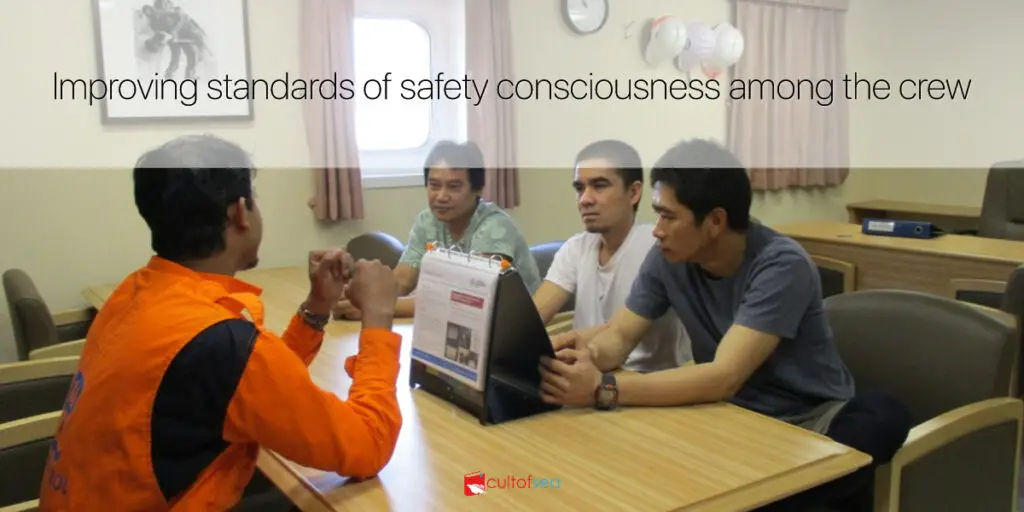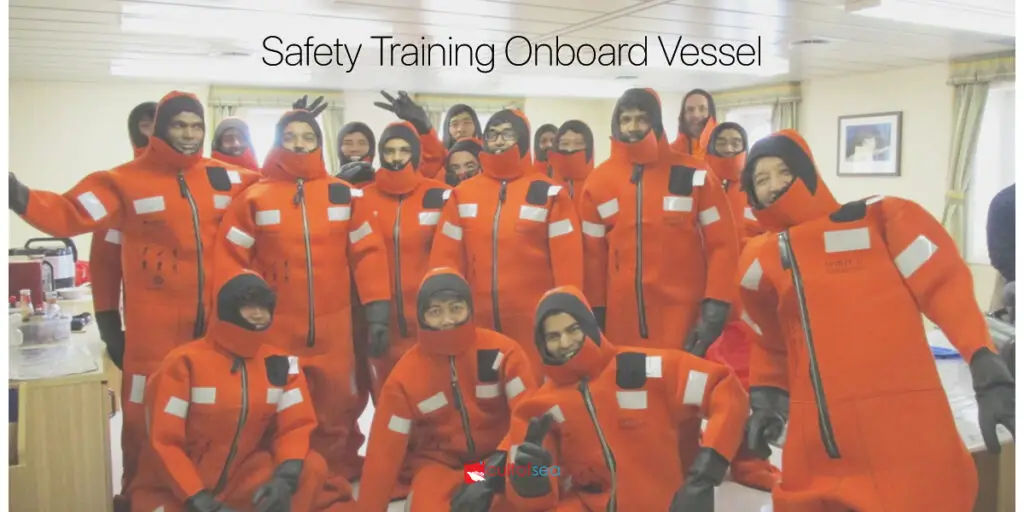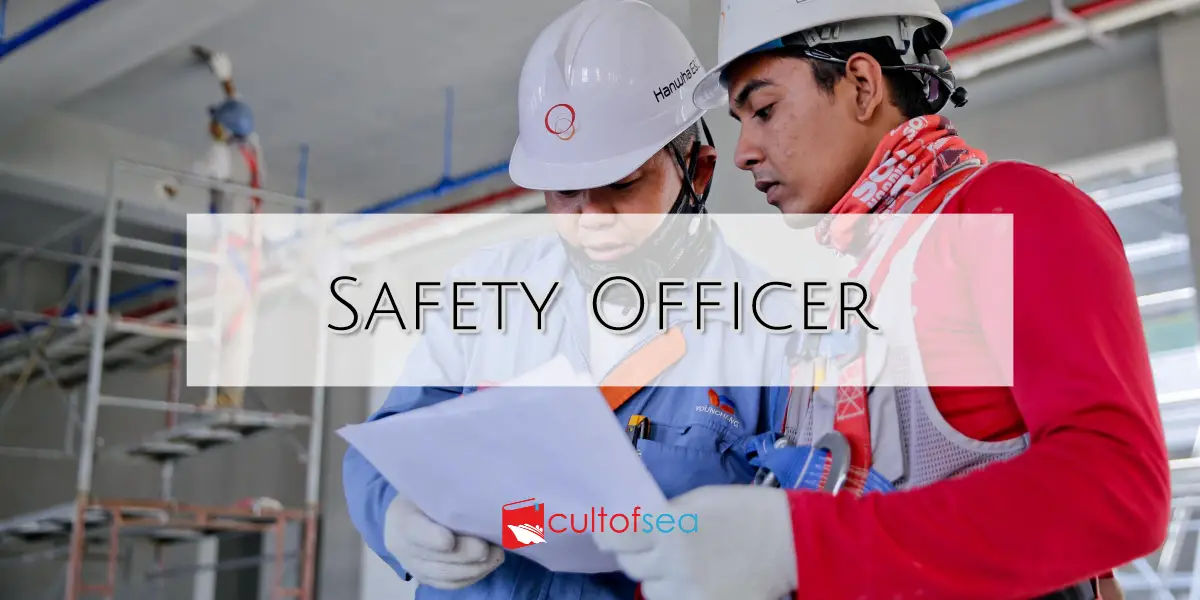Definition of Safety Officer
Safety Officer onboard the vessel is an appointed safety adviser who promotes safety onboard by carrying out inspections, identifying hazards and potential hazards to health, safety and the environment with subject to the agreement of the Master. The safety officer should be familiar with the principles and practice of risk assessment and should be available to advise those preparing and reviewing risk assessments. It is recognised that where the safety officer also has other responsibilities (e.g. chief officer) they may well conduct risk assessments themselves. However, the general principle is that the safety officer takes an independent view of safety on behalf of the Company.
The safety officer must undergo sufficient training, have experience or knowledge and other qualities to enable him or her properly to undertake the duty imposed under the relevant provision as per COSWP Chapter 13. He has, in addition, a minimum of two years’ consecutive sea service since attaining the age of 18. In the case of a tanker, the safety officer shall minimum six months service in a tanker included in the 2 years’ sea service. Appointment of a safety officer must be recorded in writing in the Official Log Book.
Duties of a Safety Officer
The safety officer’s role should be a positive one, seeking to initiate or develop safety measures before an incident occurs rather than afterwards.
The safety officer should do the following:
- Improve the standard of safety consciousness among the crew and ensure that the provisions of the Code of Safe Working Practices and safety instructions, rules and guidance for the ship relating to health and safety are complied with.
- Be on the lookout for any potential hazards and the means of preventing incidents.
- Where the unsafe practice is observed, approach the individual or responsible officer concerned to suggest improvements in the method of working or use the safety committee to discuss examples of dangerous or unsafe practices in a particular area. If this brings no improvement, the safety officer should consider approaching the head of the department or, as a last resort, the master to use their influence.
- Investigate all potential hazards to health and safety;
- Monitor and carry out the onboard safety training of seafarers.
- Investigate all reasonable complaints by workers about health and safety and make recommendations to the master to prevent their recurrence or to remove any hazard, provided that the duty to investigate will not extend to accidents arising from a casualty to the ship.
- Ensure that health and safety inspection of the ship is carried out at least every 3 months and more frequently if there are substantial changes in the conditions of work;
- Try to develop and sustain a high level of safety consciousness among seafarers so that individuals work and react instinctively in a safe manner.
- Investigate so far as possible every accident involving death, major or serious injury and every dangerous occurrence.
- Make representation and where appropriate recommendations to the master about any deficiencies in respect of health, security, safety and following:
- Maintain a record of all accidents involving death, major or serious injury and every dangerous occurrence and make it available to any elected Safety Representative, to the master and to any investigating government officials.
- Stop any work in progress, which he believes with reasonable certainty may cause an accident and report the matter immediately to the master or his deputy.
- The safety officer is not to carry out above duties in the case when emergency action to safeguard life or the ship is being taken.
- The safety officer should not be in charge of medical treatment.

Improving the standards of safety consciousness among the crew by Safety Officer
Safety Representatives
The company must make rules for the election and appointment of safety representatives. The safety representatives must be voted with the maximum votes. He must have a minimum of 2 years’ consecutive sea service since attaining the age of 18 years, which in the case of tankers must include 6 months’ tanker service.
The appointment of a safety representative will terminate on that person signing off or resigning from the company. If the ship has crew number from 6 to 15, the officers and crew should elect one safety representative. If there are more than 16, one safety representative each should be elected from the officers and the crew respectively. If there are more than 30 ratings one safety representative from the officers and three safety representatives from the rating i.e. one from the deck, one from the engine and one from the catering department. Appointment of a safety representative must be recorded in writing in the Official Log Book.
Powers of Safety Representative
- To participate subject to the concurrence of the safety officer in any investigation or inspection;
- To make a similar investigation or inspection on his own.
- To make representation to the employee on potential hazards and dangerous occurrences at the workplace;
- To make representations to the master and the employer on general matters affecting the health and safety of workers on the ship;
- To request the safety officer to carry out any occupational health and safety inspection they consider necessary and report the findings to them.
- The Master must reply to any relevant notification or query from the Safety Representative within a reasonable time frame.
- The safety representative must have a good relationship with the safety officer and should work with him to raise the safety standard onboard.
Safety Committee
Every ship having an elected safety representative must have a safety committee. The master is the chairman of that committee. The safety officer and the safety representatives are the members including any competent person chosen. The appointment of any competent person must be recorded in the Official Log Book.
The secretary of the committee should not preferably be the safety officer, as he has to concentrate on the discussions. The committee should be compact and well-knit to ensure its proper functioning. The meetings should be held every 4 to 6 weeks and as required by the circumstances.
The committee’s role is to continuously monitor the health and safety concerns of all ship’s crew and to make recommendations to the Master at any time when carrying out critical operations or during safety meetings.
A typical composition of Safety Committee comprises of the Master, Chief Engineer, and Chief Officer as the vessels Safety Officer, the Bosun and the Safety Representatives. However, this composition differs from company to company.

Duties of a Safety Committee
- To use its best endeavour to ensure that the Code of Safe Working Procedures as laid down are followed;
- A safety committee should assist in the implementation of the Health, Safety, Environment & Quality Policy. The observance of the employer’s policies and make recommendations for their improvement;
- Plan and implement accident prevention efforts onboard.
- Organize training, instruction and drills for the prevention of accidents or injuries.
- Ensure new employees are given adequate guidance and training in safety matters.
- Discuss important issues regarding onboard staff morale, health, wellbeing, social relations, crew recreation and welfare and suggest improvements.
- Provide means for the exchange of ideas, feedback and information regarding the above.
- To improve the standards of safety consciousness among the crew;
- To make representations and recommendations on the crew’s behalf on occupational health and safety matters;
- To inspect the safety officers records;
- To consider and take appropriate action concerning any occupational health and safety matters, accident reports, MS Notices, publications etc.;
- To keep a record of the meetings and any representations, replies or action resulting therefrom.

Very useful and important details are given.